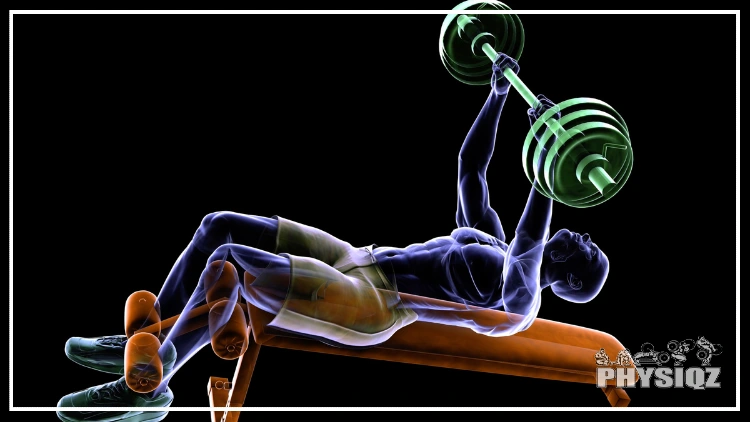
In the decline bench press, muscles worked include the chest, shoulders, arms, and back (to an extent).1 Overall, it is an effective exercise for building strength and muscle mass in all of these areas.
But, in recent years, there has been quite a bit of debate over the efficacy of the decline bench press as compared to the standard flat bench and even the incline bench press. A recent study examined the effects of performing the bench press at different angles to understand which muscles are worked, and the results were fascinating, to say the least.
But before this study can be discussed, a better understanding of the mechanics of the decline bench press should be garnered.
Decline Bench Press: Muscles Worked
The decline bench press functions much like the standard flat bench press exercise. The only difference is that the lifter is positioned on a decline bench angled at about -15 to -30 degrees.
This angle slightly changes the muscle recruitment and engages lower chest muscles as well as upper back muscles, which leads to increased muscle mass building.
One way to think about the decline bench is to compare it to the deadlift. The muscles worked during the standard deadlift differ slightly from those in the trap bar deadlift, yet both exercises target the same muscle groups, with varying emphasis on specific muscles.
Similarly, the decline bench press works all of the same muscles as the flat bench, with a slightly different emphasis on the chest and shoulders.
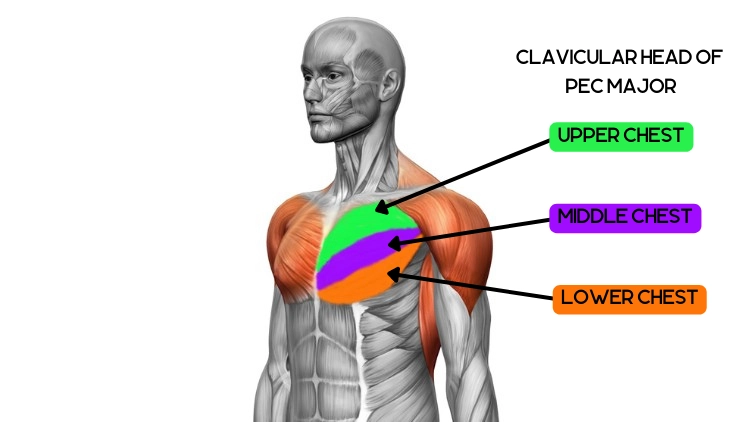
Source: Science Photo Library via Canva.com2
The primary musculature involved when performing the decline bench includes:
- Pectorals (chest)
- Triceps
- Deltoids (shoulders)
- Latissimus Dorsi (upper back)
- Trapezius (upper back)
Chest (Pectorals)
The decline bench press primarily works the pectoral muscles, which most people know as the chest. This is because the decline press is a pushing movement, but places an even greater emphasis on the chest because the weight of the barbell is shifted forward, thus, placing a greater load on the chest muscles and allowing them to be worked more.
This is beneficial for individuals aiming to increase chest muscle mass, particularly because it’s not considered the most challenging muscle to grow.
One of the primary motivations for writing this article was to note the difference between working muscles in the flat bench and the decline bench press. In comparison to the flat bench press, it should be noted that the decline bench press will target the lower chest more than the other two heads of the chest (the upper and middle chest), helping to develop a more well-rounded look for those who primarily use the incline or flat bench press.
Triceps (Triceps Brachii)
The triceps are also heavily worked during the decline bench press, as they are in any other pressing motion. The triceps are responsible for elbow extension and forearm pronation, so they will be engaged throughout the entire lift.
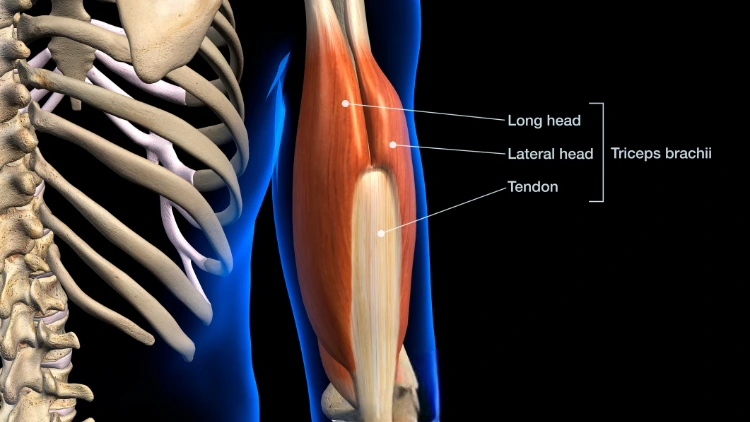
Source: Hank Grebe via Canva.com3
It should be noted that research suggests that all bench press inclinations will activate the triceps brachii to a similar level, meaning the decline bench is not necessarily superior to other bench press angles for developing the triceps.4
Shoulders (Deltoids)
The decline bench press will also work the anterior and posterior shoulders slightly, with more tension being placed on the rear delts than in other bench press variations. The deltoids are responsible for shoulder abduction, flexion, medial rotation, and extension.
Within the decline bench press, or any bench press in general, shoulder abduction, flexion, and extension will all be trained.
The decline bench press, however, shouldn’t be relied upon as the main solution for overcoming challenges related to bad shoulder genetics. It does not put the shoulder through a substantial range of motion, and it also does not load the shoulders effectively as compared to the overhead shoulder press.
Upper Back (Latissimus Dorsi)
This is one muscle group that most people never consider when performing the bench press, but when performing the incline or decline bench press, muscles worked more than in the flat bench press including the lats.
According to one study, muscle activation in the latissimus dorsi was up by over 30% when performing the decline bench, and nearly 40% when performing the incline bench.5
Now, this does not necessarily make the decline bench press a good movement for developing a strong back or even a V-taper.
However, the lasts are activated more in the incline and decline bench presses because of the slightly greater stretch that a lifter has to put the lats under when reaching for the bar as compared to the standard bench.
Traps (Trapezius)
The trapezius muscle, also known as the traps, is another muscle group that, similar to the upper back, slightly benefits from the decline bench press.
It is certainly not a primary mover in the movement, and more so acts more as a stabilizer to ensure that the scapula is retracted. Proper scapular retraction during any form of bench press is highly beneficial to ensure that the shoulders are stabilized in a safe position and the chest is maximally activated.
Some research suggests that the bench press can actually activate the traps more than the seated row, counter to what many lifters believe, but this may stem from using a specific type of form in this study.6
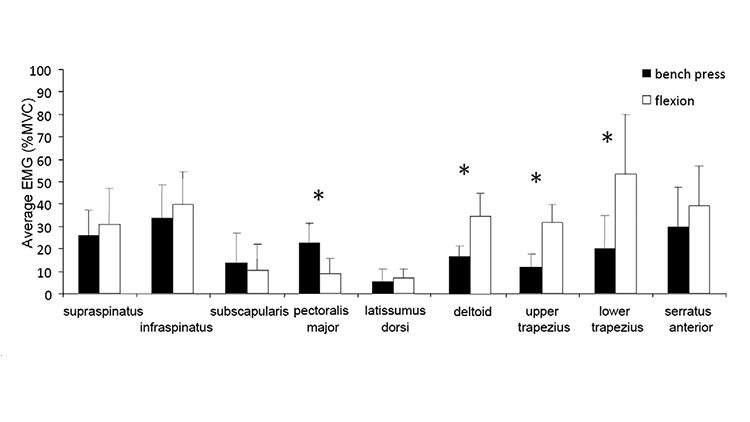
The average (+SD) EMG (% MVC) of the nine muscles during bench press and flexion exercises across all loads. ⁄Significant difference in muscle activity level between the bench press and flexion exercises (p < 0.05).
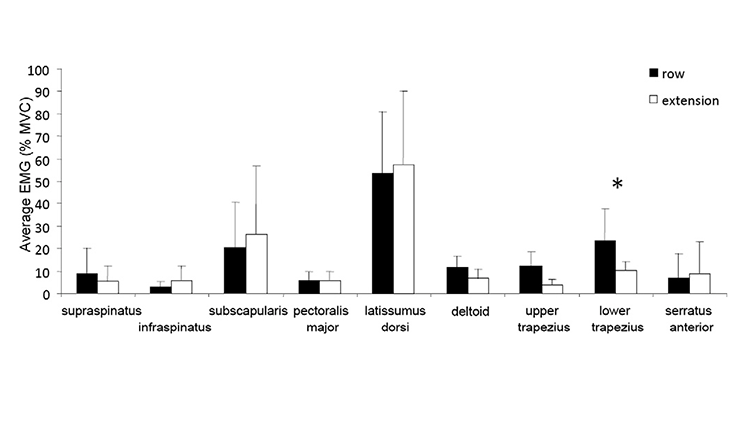
The average (+SD) EMG (% MVC) of the nine muscles during row and extension exercises across all loads. ⁄Significant difference in muscle activity level between the row and extension exercises (p < 0.05).
Regardless, this is simply to note that the traps are indeed activated when bench pressing.
How Does a Narrow or Wide Grip Affect the Working Muscles in a Decline Bench Press?
Finally, it is important to note that the muscles worked while doing a decline bench press can be slightly altered by changing up the grip.
In general, it’s believed that a wider grip works the chest more, while a narrower grip works the triceps more…but studies only show this is somewhat true.
Studies show that changing the grip when performing any bench press variation will only slightly affect which muscles are primarily worked. This is an important thing to note because if a lifter is trying to develop secondary muscle groups like the shoulders, biceps, or even the lats by changing their grip width, that is a mistake.
Adjusting grip width is best for those who want to slightly target their chest or triceps more than the other.
That being said, the aforementioned study that compared the flat bench to the incline and decline bench press muscles worked also compared a wide grip width to a narrow and medium width.
What they found was that a wide grip maximally activated the chest (pectoralis major and minor), the shoulder (anterior deltoid), the triceps brachii (triceps), and the biceps (although, they were hardly activated).
When lifters instead used a medium or narrow grip when benching, there was slightly more lat activation, but that was essentially it.
Other changes in muscle activation were inconsistent at best – a medium grip activated the chest slightly more, while a narrow grip activated it slightly less. Even more shocking was the fact that the triceps weren’t activated significantly more in a narrow grip.
But that being said, if a lifter can feel narrow grips in their triceps more (which most do), then it can be a fine tricep focused exercise.
Other research says that a wider grip width will always result in greater latissimus dorsi activation, with greater overall tricep activation the steeper the incline.7
All of this being said, when performing the decline bench press, muscles worked will likely be primarily chest, triceps, and lats to an extent, with grip width, minimally affecting which muscles are activated. Despite this, people may still ask why should one incorporate the decline bench press into their routine.
What Are the Benefits of Decline Bench Press?
The decline bench press is a great exercise for overall pec development, as it activates the entire chest. While it does not activate the upper chest as much as the incline bench press does, it does have similar muscle activation to the flat bench press.
Additionally, decline presses tend to recruit more lat activation than the flat bench press as aforementioned, which can help to add a tiny bit more volume to the back.
Another great benefit of decline bench presses is that they can increase overall pressing power as it allows lifters to use heavier weights and thus train their muscles differently. This is important for overall strength gains, as the body needs to be trained in different ways to become stronger.
Finally, decline bench presses can help lifters to work the lower chest more than other variations of the bench press. This can be beneficial for those who have an overdeveloped upper chest and want to even things out a bit.
On the safety side of things, the decline bench is the safest of any other bench press variant.
Bench presses using dumbbells are highly effective as they force the lifter to control an individual weight with each hand, forcing them to stabilize and use a variety of muscles. But at the same time, they are riskier to perform since each arm has to stabilize an individual weight, rather than a bar.
This makes them slightly risky.
The incline bench and standard flat bench are also slightly more dangerous than the decline bench since they technically place the shoulder in a disadvantageous position. In theory, if a lifter completely lost control of the bar, it could injure their shoulder.
All of this is to say: the decline bench press does not have these issues since the shoulder is placed in a very safe position as compared to either the dumbbell bench press or either the incline or flat bench. It is the safest of any bench variation, and so for lifters who are recovering from an injury or simply want to switch up their routine safely, incorporating the decline bench is a good idea.
Are There Any Downsides to the Decline Bench?
Since the decline bench press places the shoulder in a much less vulnerable position, it is one of the safest types of bench press and there’s few downsides other than the debate on the muscles it works.
Other bench presses, namely the incline and flat bench press, activate the upper chest to a greater extent than the decline bench and this means that for those who want to target the clavicular region of their pectorals, the upper chest, the decline bench is an inefficient press to perform.
Outside of that, the decline bench does not have any true downsides.
How To Perform the Decline Bench Press With Good Form & Prevent Injury
To perform the decline bench press, lay down on the bench with ankles pinned between the two foam pads. Choose a comfortable grip width, retracting the scapula to tuck the shoulders into a safe position.
Especially when performing the decline bench with heavier weight, it is a good idea to have a spotter that can lift the bar at the starting portion of the movement to ensure that the lifter is safe.
Once the bar has been lifted off the rack and the arms are extended, it is lowered straight up and down, which differs from the traditional bench press bar path. During this portion of the movement, ensure that the chest is the primary muscle felt working, as well as a slight lat stretch at the top.
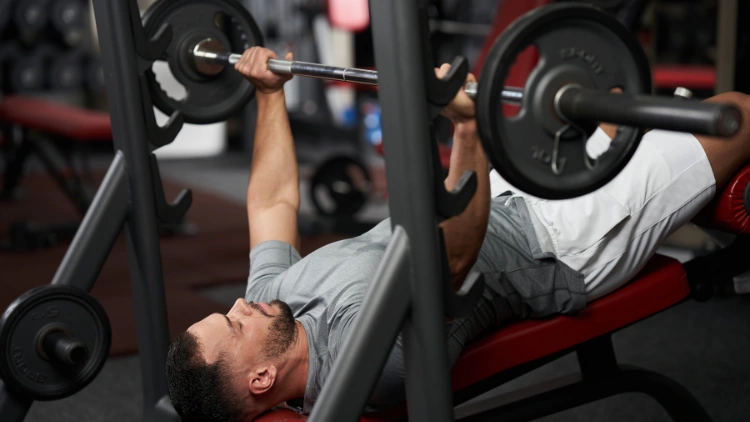
Source: Slatan via Canva.com8
After the bar has been lowered all the way to the chest, explosively push off of the chest and imagine that the arms are being clapped together. This will help to maximally activate the upper, lower, and middle chest since the pecs are activated by arm adduction.
The main thing to keep in mind here to avoid injury is to slowly build up the weight that is being used. Rather than transitioning from the flat bench to the decline bench and keeping a similar weight, dropping the weight by at least 25% is important.
This is to ensure that the movement is being performed properly and that the body has some time to adapt to the new bar path and the new stress it places on the body.
Decline Bench Press Tips & Tricks
As aforementioned, there are a few core things to keep in mind when performing the decline bench press.
Scapular retraction: Firstly, since the body is in a decline position, the lats are stretched a bit more than in the regular bench press. This means that the shoulders are a bit further away from the body, so if they aren’t properly locked into place, they could theoretically be at risk.
Tucking the shoulders back and down will effectively lock them into place – this is known as scapular retraction.
Properly retracting the scapula will also ensure that the bar lands at the correct spot on the chest. For those curious about bone where the bar should touch during bench press, specifically for the decline bench press, it should come down to the sternum, aligned with the nipples.
Use proper cues: Next, the proper cues to activate the chest as much as possible during the decline bench press include, as aforementioned, imagining that the arms are clapping together. Incorporating it into a bench press pyramid program is highly beneficial, blending moderate and lower repetitions to emphasize both strength and muscle growth.
Isolate the chest with no leg drive: Finally, one last small tip is to avoid using the feet at all. With increased bench press leg drive, individuals theoretically can lift heavier weights than relying solely on their chest muscles.
But that would defeat the purpose of performing the decline bench press – the purpose is to be challenged by a movement variation that is different from what a lifter is normally used to. Cheating the form by using the feet, or any part of the lower body is unnecessary.
Common Pitfalls When Doing a Decline Bench Press
The decline bench press, like any other exercise, has its common pitfalls.
Improper angle: One of the most common mistakes that lifters make is not properly setting up the decline bench. If the decline angle is too great, it could end up placing more strain on other muscle groups than intended.
If the angle is too low, it could lead to incorrect form and become a dangerous exercise.
Start with a lower weight: Another common mistake is forgetting to lower the weight when transitioning from a regular bench press to the decline bench press. This is important because the decline angle puts more stress on the body and can cause injury if an unprepared body is subjected to too much weight.
Use full range-of-motion and tension on the bar: Finally, many lifters forget to use proper form when performing the decline bench press. Not squeezing the bar tight, or not going down all the way to the chest before beginning their press back up to the top can change the decline bench press muscles worked, leading to less muscle activation and less overall benefit for chest growth.
What To Do if You Experience Pain When Doing a Decline Bench Press
If a lifter experiences pain when performing the decline bench press, the solution to dealing with the pain is quite a simple one, and it is the same for any other exercise: if it is uncomfortable or painful, don’t do it. It really is that easy.
For those who are concerned that they may be missing out on gains by not performing the decline bench press, let’s play out a few scenarios.
If a person continues to do the decline bench even when it is painful, perhaps hurting their shoulder or wrists, they will likely get to the point where it is too painful to perform a specific weight, and may eventually have to continually drop weight to avoid feeling pain at all. An even worse end result would be if the lifter increases weight and loses control of it, causing a severe injury that could have been avoided if the signs had been heeded.
Or, if a person feels pain when performing the decline bench press, they can do some of the things mentioned above — retracting the scapula, ensuring the bar path is correct, changing the grip width — and if none of these things work to prevent pain from happening, they switch to another bench press variation. Perhaps they use dumbbells on the decline bench and realize the barbell just did not feel good for their skeletal structure, or realize that all decline bench variations are too painful to perform.
From there, the solution to the concern about gains should be clear cut with information discussed above: the flat bench press activates all muscles in the body similarly to the decline bench press, except for the lats, so swapping to the flat bench entirely would be perfectly fine for a workout routine.
Decline Bench vs Flat Bench vs Incline Bench: Which Is Superior?
When it comes to choosing between a decline bench, flat bench, or incline bench, the answer isn’t so cut and dry. Each of these exercises has its own unique benefits and applications, so it’s important to understand the pros and cons of each one before deciding which is superior.
For instance, the decline bench press is great for targeting the lower chest and can help to develop a more well-rounded chest. On the other hand, the flat bench press is great for really hitting the mid-chest and it can be a great way to build overall benching strength.
For those wondering about the muscles worked in an incline bench press, the exercise is excellent for building strength and size in the upper and middle chest. Since it emphasizes the upper chest more and reduces strain on the lower pecs, it typically involves lifting less weight, making it more suited for advanced lifters.9
All of this being said, research shows that the steeper the incline, the more the focus will be on the front delt.10 The lesser the incline, the more emphasis there will be on the lower pec – but even then, a decline of -15 degrees will have a similar lower pec activation to the standard 0-degree bench press.
This research also suggests that the flat bench press and decline bench press activate the upper body musculature in a very similar way; for example, the decline bench press only activates the lower chest slightly more.
So, if a lifter wants to target their front delt more when benching, the incline bench is effective for doing so, but targeting the lower pec can be achieved either through the decline or the bench press.
How the Angle of the Bench Press Targets Different Parts of the Chest
As aforementioned, different angles of the bench press can help target different parts of the chest. The angle is important to consider as it will determine what muscles are being used and how much weight can be lifted.
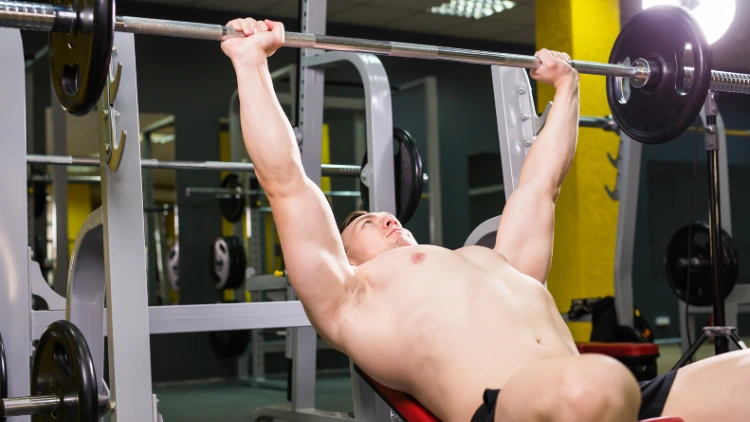
Source: Изображения пользователя Tatiana via Canva.com11
The standard flat bench press is the most common angle used for targeting the mid-chest. A slight incline of 10 to 15 degrees would be great for targeting the upper chest and anterior deltoid, while a decline angle of -15 degrees will target the lower pec slightly more than either the standard or incline bench presses.
So if a person has primarily been performing the incline bench press for a long time, it is likely that their lower chest has not been receiving the activation that it should. In the decline bench press, muscles worked include targeting the lower pec better than any other bench press variation, so switching to it can only be beneficial to develop a more symmetrical and aesthetic physique, even if it is only slightly more effective than the flat bench.
Frequently Asked Questions
Is the Decline Dumbbell Bench Press or Barbell Decline Press Bench Better?
It depends. The standard barbell decline bench press is great for progressively overloading and pushing as much weight as possible, but the decline dumbbell press is likely more effective for putting the chest through a larger range of motion and training each arm to be unilaterally strong.
Is the Decline Chest Press Machine Better Than Dumbbell or Barbell Decline Bench?
The only downside of the decline chest press machine is the same issue that machines have in general: they take the stabilizing muscles out of the equation. Meaning, compared to the dumbbell or barbell decline bench presses, the machine version requires fewer stabilizer muscles in the chest and arms to assist and may lead to imbalances with long-term uses.
Should I Arch My Back While Doing a Decline Bench Press?
In all honesty, the answer to this question is that it is up to the individual. Each person has a slightly different skeletal structure, so for some people, arching their back on the decline bench press will help them lift more while being pain-free; for others, it does the exact opposite, hurting them, and lowering their weight potential.
References
1Devrimb. Canva. Accessed 20 April 2023. <https://www.canva.com/photos/MAFYXJGqnGQ-decline-barbell-press/>
2Science Photo Library. Canva, <https://www.canva.com/photos/MADmTGwAFbo-the-muscles-involved-in-standing-biceps-curl-the-stabilizing-muscles-are-highlighted-/>
3Grebe, Hank. Canva, <https://www.canva.com/photos/MAEJnzTxmJU-labeled-anatomy-chart-of-shoulder-elbow-and-triceps-muscles-in-skeleton-on-black-background/>
4Rodríguez-Ridao, D., Antequera-Vique, J. A., Martín-Fuentes, I., & Muyor, J. M. (2020). Effect of five bench inclinations on the electromyographic activity of the pectoralis major, anterior deltoid, and triceps brachii during the bench press exercise. International Journal of Environmental Research and Public Health, 17(19), 7339. <https://doi.org/10.3390/ijerph17197339>
5Saeterbakken, A. H., Mo, D.-A., Scott, S., & Andersen, V. (2017). The effects of bench press variations in competitive athletes on muscle activity and performance. Journal of Human Kinetics, 57, 61–71. <https://doi.org/10.1515/hukin-2017-0047>
6Wattanaprakornkul, D., Halaki, M., Cathers, I., & Ginn, K. A. (2011). Direction-specific recruitment of rotator cuff muscles during bench press and row – PubMed. Journal of Electromyography and Kinesiology : Official Journal of the International Society of Electrophysiological Kinesiology, 21(6). <https://doi.org/10.1016/j.jelekin.2011.09.002>
7Barnett, C., Kippers, V., & Turner, P. (1995). Effects of variations of the bench press exercise on the EMG activity of five shoulder muscles. The Journal of Strength & Conditioning Research, 9(4), 222-227. <https://journals.lww.com/nsca-jscr/abstract/1995/11000/effects_of_variations_of_the_bench_press_exercise.3.aspx>
8Slatan. Canva. Accessed 20 April 2023. <https://www.canva.com/photos/MAEiP-j9l-g-man-doing-barbell-bench-press/>
9Cabral, H. V., de Souza, L. M. L., de Oliveira, L. F., & Vieira, T. M. (2022). Non-uniform excitation of the pectoralis major muscle during flat and inclined bench press exercises – PubMed. Scandinavian Journal of Medicine & Science in Sports, 32(2) <https://doi.org/10.1111/sms.14082>
10Lauver, J. D., Cayot, T. E., & Scheuermann, B. W. (2016). Influence of bench angle on upper extremity muscular activation during bench press exercise – PubMed. European Journal of Sport Science, 16(3). <https://doi.org/10.1080/17461391.2015.1022605>
11Изображения пользователя Tatiana. Canva. Accessed 20 April 2023. <https://www.canva.com/photos/MAEsXis9zcg-weightlifter-at-the-bench-press-lifting-a-barbell-on-an-incline-bench-/>